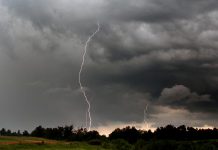
October marks one of my favourite holidays, Halloween, which is a time for a celebration of all things spooky. It’s time to carve pumpkins, decorate our homes with strings of bats and spiders, and tuck rubber snakes and rats under fallen leaves for unsuspecting trick-or-treaters.
As you dig your decorations out of storage, you may notice that many local animals are associated with All Hallows’ Eve. There are different spiritual interpretations and myths related to many species, but what are they actually up to this time of year?
GreenUP caught up with local naturalist Drew Monkman to find out more about our favourite creepy creatures.
Bats!

An inherent fear of bats is common and, whether we think they are going to bite us or spread disease, many of us try to avoid them. Some of our favourite Halloween traditions are built on this fear, with vampires coming to mind.
In Ontario, there are eight species of bats, four of which are species at risk. According to Monkman, if anything, “We should be afraid for bats!”
“The population of bats in Ontario has dropped by 90 percent in the last ten years with the arrival of White-Nose Syndrome,” says Monkman, “This is an extinction tragedy of unprecedented proportions. You don’t have to find bats warm and cuddly to feel great sadness in the crisis they are now facing.”
Little brown bats have been heavily impacted by White-Nose Syndrome (WNS) and it is predicted that they will go extinct in the wild. In Ontario, the majority of our bat species do not migrate, but instead hibernate in nearby caves or abandoned sites called hibernacula.
Locally, bats have hibernated in abandoned mine shafts in the Bancroft area, at the Warsaw Caves complex, and even in buildings and older houses.

Bats survive hibernation by lowering their body temperatures. WNS, which is a fungal infection, affects our local bat species’ during hibernation by waking them up, causing their temperature to prematurely rise.
It is unlikely you will run into a real bat this Halloween, but you can do your part for them by installing a bat house, which will provide a place for bats to roost during the day and raise their young.
As a bonus, bats eat thousands of bugs in a night, so they will help keep pests away from your yard.
Snakes!

Are you afraid of snakes?
Snakes are reptiles that evoke fear in many of us. Snakes are elusive; they move quickly and may try to bite if they are cornered or caught off guard.
This time of year, snakes descend below the frost line in order to survive the winter.
“Rodent burrows and rock crevices are both common hibernacula locations,” explains Monkman.
The only snake you’re likely to encounter this Halloween is a rubber snake, as most species have already moved to their hibernation sites throughout the month of October.
Crows!

Crows commonly eat carrion, which are animals that they find already dead. You have likely seen a crow along the side of the road, pecking away on some road kill.
This probably contributes to their reputation as spooky creatures, along with the fact that a group of crows is called a “murder”. The phrase “murder of crows” may have been coined as groups of crows scavenging for food became associated with the dead things they eat.
Movies, books, and campfire stories often portray crows as portents of doom and consorts of witches but these birds are beautiful and remarkably intelligent. In reality, during the fall, crows are mostly concerned with where their next meal will come from.

“In winter, most crows migrate to southern Ontario or to the northern U.S. where food is more easily available,” Monkman explains. “An increasing number remain here in the Kawarthas, especially during mild winters. Crows often glean spilled corn, soybeans, and carrion along with just about anything else they can find. Their main adaptation is being the ultimate omnivore.”
Snakes, and crows, and brown bats, oh my! This October 31st, when you see these local species transformed into spooky Halloween decorations alongside skeletons and goblins, you’ll know their real story in nature.
For more information about local flora and fauna, visit www.drewmonkman.com where you can find a wealth of knowledge about nature in the Kawarthas.
You can also visit the GreenUP Store at 378 Aylmer Street North in downtown Peterborough to purchase a locally made bat box to hang in your own backyard and to pick up signed copies of Drew Monkman’s books, Nature’s Year and The Big Book of Nature Activities, co-written with Jacob Rodenburg.


























